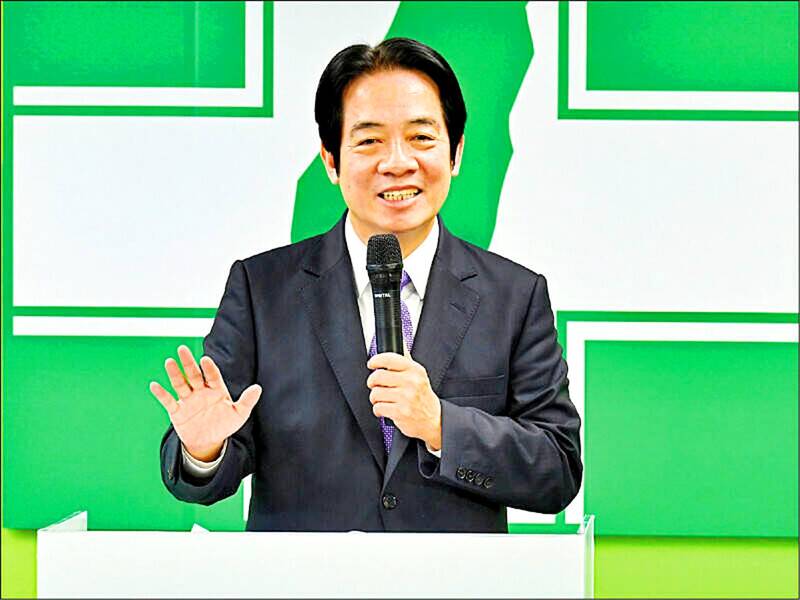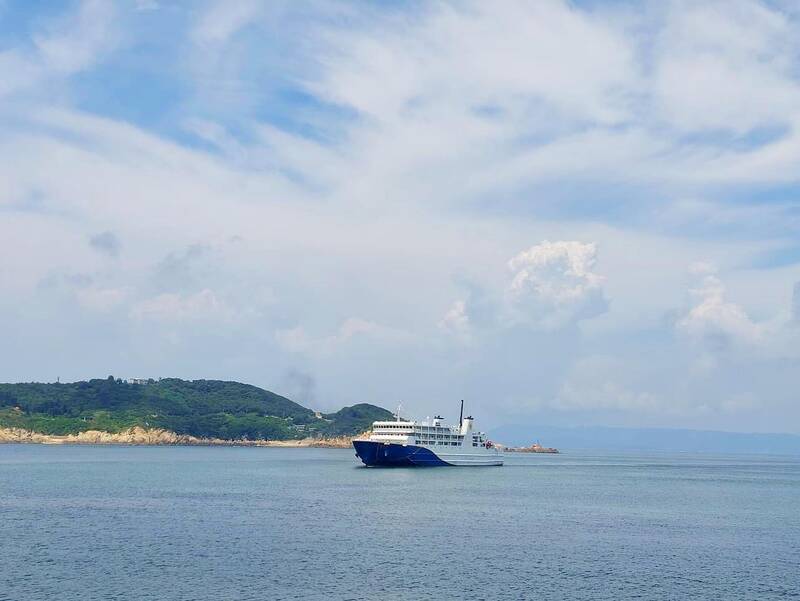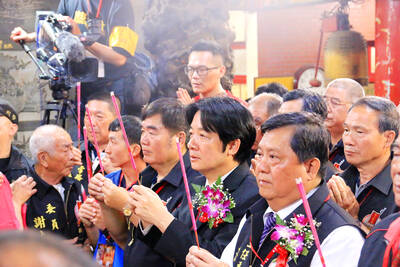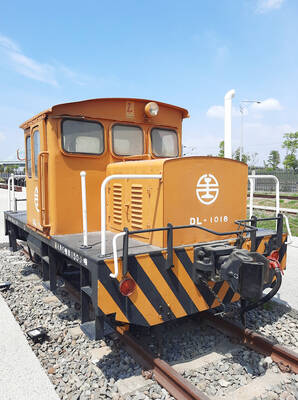Ahead of incoming president William Lai’s (賴清德) inauguration on May 20 there appear to be signs that he is signaling to the Chinese Communist Party (CCP) and that the Chinese side is also signaling to the Taiwan side. This raises a lot of questions, including what is the CCP up to, who are they signaling to, what are they signaling, how with the various actors in Taiwan respond and where this could ultimately go.
In the last column, published on May 2, we examined the curious case of Democratic Progressive Party (DPP) heavyweight Cheng Wen-tsan (鄭文燦) — currently vice premier and name frequently raised as a potential premier or presidential candidate — who accepted a huge demotion to run the Straits Exchange Foundation (SEF), which is a quasi-private organization tasked with representing Taiwan’s Mainland Affairs Council (MAC) in any actual meetings with Beijing to get around the two governments not officially talking to each other. Since President Tsai Ing-wen (蔡英文) came to office, the CCP cut off all contact with the SEF over Tsai’s stance on the so-called “1992 consensus,” effectively rendering the SEF irrelevant.
In summary, while there is a possibility this is an internal DPP power play by Lai, it seems more likely that Lai is signaling to the CCP that he is willing to reopen communications and that by placing one of the most powerful figures in the DPP who has the ear of the top leadership, he is serious. That Cheng took the job suggests there is something significant going on, and Lai campaigned on reopening talks with China.

Photo: Taipei Times, file photo
THE WANG HUNING ANGLE
At the 20th Party Congress of the CCP in October of 2022, Wang Huning (王滬寧) was promoted to the fourth-ranked position in the CCP Politburo Standing Committee (PSC). This position puts him in charge of the CCP United Front Work Department (UFWD), in the chair position of the Chinese People’s Political Consultative Conference (CPPCC) and deputy chair of the CCP Central Leading Small Group for Taiwan Work, which is the second highest position in charge of Taiwan policy after only President Xi Jinping (習近平).
Wang has been known as one of the top ideological thinkers in the CCP and is probably best known in the US as the author of America Against America, which some consider an influential look in China on American culture, society and economy. In Taiwan, he is possibly known the most for being the “three dynasty imperial teacher” (三朝帝師) who has been involved in crafting the messaging and ideological underpinnings of three successive CCP leaders and has remarkably survived the court purges that happen when a new leader entrenches power.

Photo courtesy of the DPP
In the spring of last year, starting in a piece in Nikkei Asia but spreading to other outlets, there was considerable speculation that he was being tasked with formulating a new ideological framework and approach for unification with Taiwan, possibly even going so far as to replace the Deng Xiaoping (鄧小平) era “One Country, Two Systems,” which is deeply unpopular in Taiwan. China analysts watched and analyzed anything and everything that could provide some insight into what, if anything, Wang might do to change CCP strategy on Taiwan.
Not much changed. It appeared that Wang was simply doubling down on the strategies they have been pursuing since the late 2010s.
INTENSIFYING SCALE SIGNIFICANT
There are now indications changes are afoot on the Chinese side, though it is too early to know how significant and sweeping they might be. They are only just beginning to tip their hand, and if there are significant changes coming they will likely play out their strategy over some time and taking into account actions by the Taiwanese side as well as other stakeholders, including the US and Japan.
That this is happening in the run-up to Lai’s inauguration is almost certainly no accident. There appear to be both carrot and stick elements to their messaging, which appears to carry the message that there are both costs and benefits to be had through communication.
So far none of the changes are exactly new, but the intensifying scale is telling. For example, the Chinese side had made a change to the M503 flight path once previously in the Taiwan Strait without consulting the Taiwan side as they did in 2015, but this time they not only moved it closer to the median line between the two sides, they created three new flight paths, including one only 1.1 nautical miles from Kinmen County airspace and another 2.8 nautical miles south of Matsu airspace. All these changes are dangerously close and the chances for accidents to occur are alarming.
Also not new are tensions around Kinmen, but following a Chinese speedboat accident as Taiwan’s Coast Guard was chasing them out of Taiwan’s water things have escalated significantly. Beijing increased patrols around Kinmen and brought them in much closer, boarded and inspected a Taiwanese tourist boat and has been holding a Taiwanese fisherman they claim is a member of Taiwan’s military.
Also escalating and closing in is the recent high numbers of incursions by the CCP’s armed wing, the People’s Liberation Army Air Force (PLAAF) and Navy (PLAN) into Taiwan’s air defense identification zone (ADIF), including incursions as close as 41 nautical miles away from Keelung’s naval base, rattling Taiwan and setting off alarm bells. There have still been no incursions in Taiwan’s legal airspace, but the chances that they accidentally do or have a collision with a Taiwanese air force vessel are rising significantly. Both have the potential to lead to armed conflict.
OUTSIZED REWARD
Late last month, Chinese Nationalist Party (KMT) caucus convener Fu Kun-chi (傅?萁 aka the “King of Hualien”) led a delegation of 17 party lawmakers, or about one-third of the party caucus, to visit China. Wang met with the delegation in a setting often reserved for state visits.
With previous KMT delegations, the CCP would sometimes “reward” the KMT by lifting some import restrictions on Taiwanese products, usually one or two agricultural products, but not significant in the overall economic picture but carrying some symbolic weight. Not this time.
Not only were import restrictions to be dropped for 16 products, the Beijing announced plans to revive cross-strait tourism, which it cut off to show displeasure with the Tsai administration and to deal her an economic blow. In one year between 2015 and 2016, Taiwan’s tourism revenue dropped from US$14.39 billion to US$10.37 as Chinese tourism dried up.
However, by 2019 tourism revenues had been restored to US$14.41 billion due to increasing Japanese and Southeast Asian tourism in particular, and reached US$14.89 billion in 2022 post-pandemic. Anecdotally, there has been speculation that tourists from these countries increased their tourism to Taiwan in part due to the absence of Chinese tourists.
Initially the CCP has indicated it will act swiftly to begin tourism between Fujian and Matsu, but called on the Taiwan “authorities” to resume ferry traffic route between Pingtan Island, Fujian and Taiwan itself, to revive many of the 30 direct flight routes that have withered in recent years between the two sides, and announced a pilot program where Chinese in 20 cities will be able to apply for exit and entry documents for Chinese to travel to Taiwan online. MAC Minister Chiu Tai-san (邱太三) said Taiwan welcomes Chinese tourists. If the CCP follows through on lifting restrictions on outbound tourism to Taiwan, this could potentially mean billions in inbound revenue for Taiwan.
Why tourism? It might be significant that Wang Huning is in charge of the United Front Work Department. It is far easier to recruit spies, subvert local elites, reconnect with underworld figures and temples and plant potential saboteurs with thousands of Chinese operating openly in Taiwan.
THE BIG QUESTION
The big unanswered question is who is the CCP planning to communicate with and under what formula.
If they are planning to communicate via the quasi-private organizations previously used, Taiwan’s SEF and China’s equivalent Association for Relations Across the Taiwan Straits (ARATS), then some workaround would need to be found on the issue of the CCP’s insistence on the “1992 consensus.”
The other possibility could be that the CCP is planning to in essence use the KMT to replace the SEF and use the KMT’s legislative plurality in concert with the Taiwan People’s Party (TPP), effectively driving a dangerous wedge into Taiwan’s politics.
We will examine those two possibilities and potential dangers ahead in an upcoming deep dive.
Donovan’s Deep Dives is a regular column by Courtney Donovan Smith (石東文) who writes in-depth analysis on everything about Taiwan’s political scene and geopolitics. Donovan is also the central Taiwan correspondent at ICRT FM100 Radio News, co-publisher of Compass Magazine, co-founder Taiwan Report (report.tw) and former chair of the Taichung American Chamber of Commerce. Follow him on X: @donovan_smith.

The Democratic Progressive Party (DPP), Chinese Nationalist Party (KMT), and the country’s other political groups dare not offend religious groups, says Chen Lih-ming (陳立民), founder of the Taiwan Anti-Religion Alliance (台灣反宗教者聯盟). “It’s the same in other democracies, of course, but because political struggles in Taiwan are extraordinarily fierce, you’ll see candidates visiting several temples each day ahead of elections. That adds impetus to religion here,” says the retired college lecturer. In Japan’s most recent election, the Liberal Democratic Party lost many votes because of its ties to the Unification Church (“the Moonies”). Chen contrasts the progress made by anti-religion movements in

Taiwan doesn’t have a lot of railways, but its network has plenty of history. The government-owned entity that last year became the Taiwan Railway Corp (TRC) has been operating trains since 1891. During the 1895-1945 period of Japanese rule, the colonial government made huge investments in rail infrastructure. The northern port city of Keelung was connected to Kaohsiung in the south. New lines appeared in Pingtung, Yilan and the Hualien-Taitung region. Railway enthusiasts exploring Taiwan will find plenty to amuse themselves. Taipei will soon gain its second rail-themed museum. Elsewhere there’s a number of endearing branch lines and rolling-stock collections, some

Last week the State Department made several small changes to its Web information on Taiwan. First, it removed a statement saying that the US “does not support Taiwan independence.” The current statement now reads: “We oppose any unilateral changes to the status quo from either side. We expect cross-strait differences to be resolved by peaceful means, free from coercion, in a manner acceptable to the people on both sides of the Strait.” In 2022 the administration of Joe Biden also removed that verbiage, but after a month of pressure from the People’s Republic of China (PRC), reinstated it. The American

Chinese Nationalist Party (KMT) legislative caucus convener Fu Kun-chi (傅?萁) and some in the deep blue camp seem determined to ensure many of the recall campaigns against their lawmakers succeed. Widely known as the “King of Hualien,” Fu also appears to have become the king of the KMT. In theory, Legislative Speaker Han Kuo-yu (韓國瑜) outranks him, but Han is supposed to be even-handed in negotiations between party caucuses — the Democratic Progressive Party (DPP) says he is not — and Fu has been outright ignoring Han. Party Chairman Eric Chu (朱立倫) isn’t taking the lead on anything while Fu